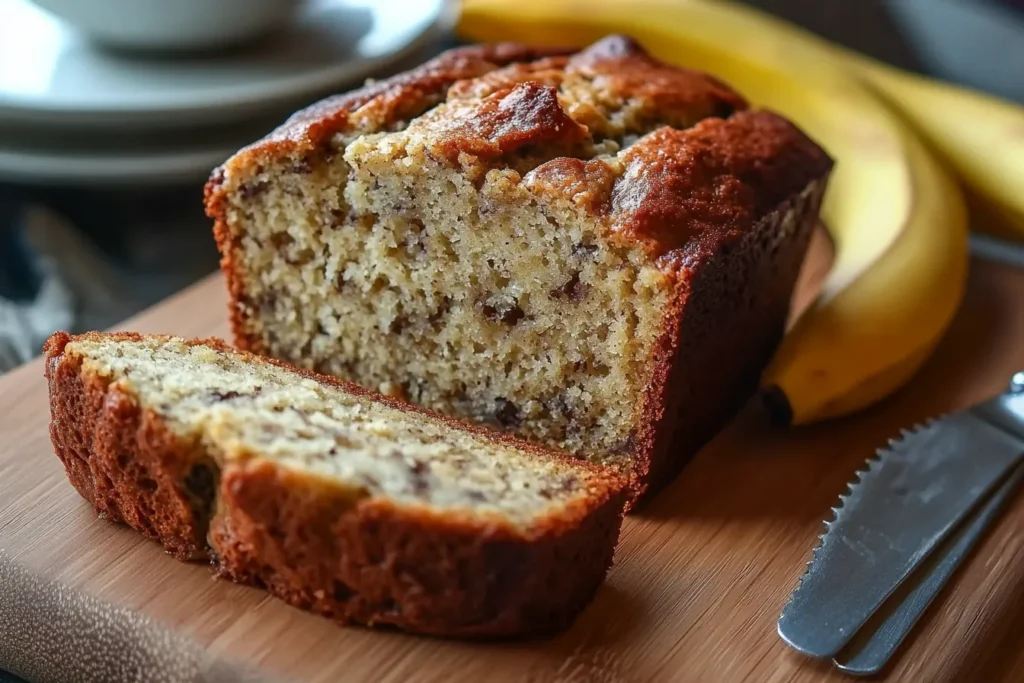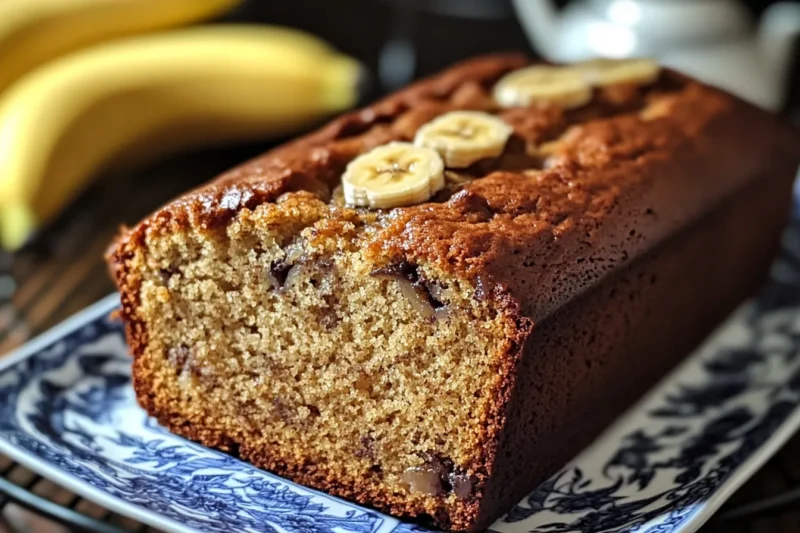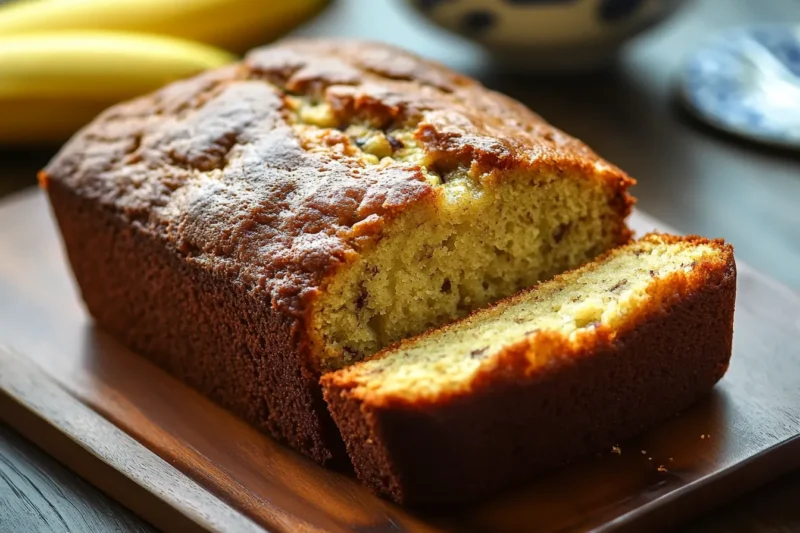Key Takeaways
- Discover the benefits of using oil instead of butter in your banana bread
- Learn the essential ingredients for a perfectly moist and flavorful loaf
- Uncover the best techniques for mixing and baking to achieve a fluffy texture
- Get tips on selecting and preparing ripe bananas for maximum flavor
- Explore healthy substitutions and variations to customize your banana bread
Why Choose Oil Over Butter in Banana Bread
Choosing between oil and butter in banana bread matters a lot. Both can make tasty loaves, but oil has some big pluses. It’s worth thinking about these benefits.
Health Benefits of Using Oil
Some oils, like olive oil or coconut oil, are good for you. They have less bad fat and more good fats. This makes them better than butter for your health.
Moisture Retention Properties
Oil keeps banana bread moist and soft for longer. It doesn’t dry out like butter can. This is great for keeping your bread fresh for days.
Cost-Effective Baking
Oil is cheaper than butter, which is good for your wallet. It’s especially helpful if you bake a lot or are watching your spending. Saving money on ingredients is always a plus.
Whether you pick oil or butter, it’s about what you like best. The most important thing is finding what works best for you and your baking.
Essential Ingredients for Perfect Banana Bread
Making a tasty banana bread needs the right mix of ingredients. The ripe bananas are the main attraction. Then, there are the binding agents and leavening agents that make the bread come together. Knowing how each ingredient works helps you make a moist and flavorful loaf every time.
Here are the key ingredients you’ll need for a great banana bread:
- Ripe Bananas: Bananas that are too ripe, with brown spots, are perfect. They add sweetness and moisture to the mix.
- Vegetable Oil: This oil keeps the bread soft and moist. It’s better than butter because it doesn’t make the bread heavy.
- Eggs: Eggs help the batter stick together. They also add to the bread’s structure.
- Sugar: Sugar, whether white or brown, makes the bread sweeter. It also helps the crust brown nicely.
- Flour: All-purpose flour is the base of the bread. It gives the bread its structure and texture.
- Baking Soda: This ingredient makes the bread rise. It helps it become light and fluffy.
- Salt: A little salt enhances the flavors. It balances out the sweetness of the bread.
While these ingredients are the core of banana bread, you can also add your own twist. Try adding cinnamon, vanilla, or nuts for extra flavor and texture. By understanding each ingredient’s role, you can experiment and find your favorite banana bread recipe.
Banana Bread Recipe with Oil
Making a moist and tasty banana bread is simple, especially with oil instead of butter. This banana bread recipe with oil will help you get the perfect texture and flavor every time.
Required Kitchen Tools
- Loaf pan (9×5 inches)
- Mixing bowls (one large, one medium)
- Whisk or electric hand mixer
- Spatula
- Parchment paper
Preparation Time
This banana bread recipe with oil takes about 1 hour and 15 minutes. You’ll spend 15 minutes preparing and 60 minutes baking.
Cooking Temperature and Duration
Heat your oven to 350°F (175°C). Bake the banana bread for 60 minutes. It’s done when a toothpick in the center comes out clean.
By following this banana bread recipe with oil, you’ll get a moist and flavorful loaf. It’s great for breakfast, snacks, or dessert. Use ripe, tasty bananas for the best taste.
| Ingredient | Amount |
|---|---|
| Mashed ripe bananas | 1 1/2 cups |
| Vegetable oil | 1/2 cup |
| Granulated sugar | 3/4 cup |
| Eggs | 2 |
| Vanilla extract | 1 teaspoon |
| All-purpose flour | 1 1/2 cups |
| Baking soda | 1 teaspoon |
| Salt | 1/4 teaspoon |
With this banana bread recipe with oil, you’ll soon enjoy a moist and delicious homemade loaf. Just remember to adjust the baking temperature for banana bread and time for the perfect texture.
Selecting and Preparing Ripe Bananas
Choosing the right bananas is key for baking the perfect ripe bananas for baking. Too ripe bananas can make the bread dense. Too green bananas might not add enough sweetness and moisture. You want bananas that are just right.
For your can I replace oil with banana recipe, pick bananas with a golden yellow peel and brown spots. These are the perfect ripeness for a moist and tasty banana bread. Stay away from bananas that are all green or too brown, as they might not work as well.
- Peel the ripe bananas and mash them with a fork or potato masher until they’re smooth and creamy.
- For the best banana bread, use about 1 cup of mashed ripe bananas per loaf.
- If your bananas are very ripe, with lots of brown spots, you might need to use less oil. The bananas add extra moisture.
| Banana Ripeness | Ideal for Baking | Impact on Texture and Flavor |
|---|---|---|
| Green | No | Starchy, lacking in sweetness |
| Partially Ripe (Yellow with a few brown spots) | Yes | Balanced sweetness and moisture |
| Overripe (Mostly brown) | Yes, but reduce oil | Extremely sweet, dense texture |
By picking the right ripe bananas for baking and preparing them well, you’ll make a moist and tasty banana bread. It’s sure to please your taste buds.
Mixing Techniques for Fluffy Texture
To make a light and fluffy banana bread, you need the right mixing techniques. Understanding how to mix wet and dry ingredients and fold the batter is key. This will help you make a moist and airy loaf every time. Let’s explore the essential steps for mixing that will give you a fluffy banana bread.
Wet Ingredients Combination
Begin by mashing the ripe bananas in a large bowl. Next, add the oil, eggs, and other wet ingredients. Use a whisk or hand mixer to mix until smooth. But don’t overmix, as it can make the bread dense and tough.
Dry Ingredients Integration
In another bowl, whisk together the dry ingredients like flour, baking soda, and spices. Slowly add the dry mix to the wet ingredients, folding gently with a spatula. Don’t mix too hard, as it can make the bread tough.
Proper Folding Methods
- Use a spatula to gently fold the batter, cutting through the center and lifting the batter from the bottom to the top.
- Fold the batter until the dry ingredients are just mixed in, being careful not to overmix.
- Keep the texture light and airy by avoiding too much stirring or beating, which can make the bread dense.
By using these mixing techniques, you’ll be on your way to making a fluffy and moist banana bread that will impress everyone. The secret is to handle the batter gently, ensuring a light and airy texture in every slice.
Common Mistakes to Avoid When Baking
One big reason banana bread might not be fluffy is overmixing the batter. Vigorous mixing can develop too much gluten, leading to a dense, tough texture. Mix the wet and dry ingredients gently, folding them together until just combined.
- Accurately measure the ingredients: Wrong measurements, especially with flour, can change the bread’s texture. Use a reliable scale or measuring cups for exact amounts.
- Avoid overbaking: Overbaking can result in a dry, crumbly banana bread. Watch the baking time closely and use a toothpick or cake tester to check for doneness. Adjust the time if needed to prevent overcooking.
- Properly prepare the baking pan: Not greasing and flouring the pan can make the bread stick. This can make it hard to remove and affect the bread’s look.
- Use ripe, mashed bananas: Underripe bananas may not provide enough moisture and flavor, leading to a subpar loaf. Make sure your bananas are ripe and mashed well before adding them to the batter.
By remembering these common banana bread baking mistakes and taking the right steps, you can make a moist, fluffy, and delicious loaf every time. With a bit of attention to detail and awareness of potential issues, you’ll no longer wonder why did my banana bread not come out fluffy.
| Mistake | Cause | Solution |
|---|---|---|
| Overmixing the batter | Develops too much gluten, leading to a dense, tough texture | Use a light hand when combining the wet and dry ingredients, folding gently until just combined |
| Inaccurate ingredient measurements | Flour, in particular, can significantly impact the final texture | Use a reliable scale or measuring cups for precise proportions |
| Overbaking the loaf | Results in a dry, crumbly banana bread | Keep a close eye on the baking time and use a toothpick or cake tester to check for doneness |
| Improper pan preparation | Causes the banana bread to stick, affecting the appearance | Grease and flour the baking pan thoroughly before pouring in the batter |
| Using underripe bananas | Provides insufficient moisture and flavor | Ensure your bananas are ripe and mashed thoroughly before adding to the batter |
Storage Tips and Shelf Life
Keeping your homemade banana bread fresh is all about proper storage. Follow these tips to keep your banana bread moist and flavorful for longer.
Room Temperature Storage
Store your banana bread at room temperature for the best results. Wrap it in plastic wrap or aluminum foil. It will stay fresh for up to 4 days. Make sure it’s in a cool, dry spot, away from sunlight and heat.
Freezing Methods
- To store it longer, freeze your banana bread. Let it cool completely first, then wrap it tightly in plastic or foil.
- Put the wrapped bread in a resealable freezer bag. Squeeze out air before sealing.
- Frozen banana bread stays good for up to 3 months.
Reheating Instructions
To reheat frozen banana bread, thaw it at room temperature for a few hours. Then, warm it in the oven at 300°F for 10-15 minutes.
With the right storage and reheating, your banana bread can last for days or weeks. Follow these tips to enjoy a delicious slice whenever you want.
Healthy Substitutions and Variations
Make your classic banana bread healthier with new ingredients and flavors. You can cut calories or try new tastes. These changes will make your healthy banana bread recipe even better.
Healthier Ingredient Swaps
- Use whole wheat flour or oat flour instead of white flour for more fiber and nutrients.
- Try honey, maple syrup, or applesauce instead of sugar for a natural sweetener.
- Replace oil or butter with Greek yogurt or unsweetened applesauce to reduce fat and calories.
- Add ground flaxseed or chia seeds for extra omega-3s.
Flavor-Packed Variations
Try these add-ins to make your banana bread variations even tastier:
- Add toasted nuts like walnuts or pecans for a crunchy texture.
- Mix in chocolate chips, dried fruit, or peanut butter for a sweet treat.
- Use warm spices like cinnamon, nutmeg, or cardamom for a cozy smell.
- Top with a streusel or crumb topping for a bakery look.
| Ingredient | Traditional Recipe | Healthy Substitution |
|---|---|---|
| Flour | All-purpose flour | Whole wheat flour or oat flour |
| Sweetener | Granulated sugar | Honey, maple syrup, or unsweetened applesauce |
| Fat | Butter or oil | Greek yogurt or unsweetened applesauce |
| Additions | Chocolate chips or dried fruit | Toasted nuts, flaxseed, or chia seeds |
With these healthy banana bread recipe changes and banana bread variations, you can enjoy a tasty and healthy treat. Try different combinations to find your favorite.
Troubleshooting Banana Bread Problems
Baking banana bread can be fun, but sometimes it doesn’t turn out right. If your banana bread is too dry or has texture problems, don’t worry. We have solutions for you.
Texture Issues
Getting banana bread to be moist and tender can be tricky. If your loaf is dry and dense, there are a few reasons:
- Overbaking: Watch the oven closely. Take the bread out when a toothpick comes out clean but the inside is still a bit moist.
- Incorrect banana ratio: Make sure you use the right amount of ripe, mashed bananas for the perfect moisture.
- Overmixing: Mix the wet and dry ingredients gently to avoid making the bread tough.
Baking Challenges
Another issue is banana bread baking unevenly or having a sunken center. These problems can come from:
- Oven temperature fluctuations: Make sure your oven is set right and keeps the temperature steady.
- Improper pan size: Use the right loaf pan size for even baking and a nice, domed top.
- Underbaking: Keep an eye on it and bake until a toothpick comes out clean.
Common Fixes
If you face these problems, there are simple fixes to get your banana bread right:
- For dry, dense texture: Add more mashed bananas or a tablespoon of oil or applesauce to the batter.
- For uneven baking or a sunken center: Adjust the oven temperature, use the correct pan size, and make sure it’s fully baked.
By following these tips, you’ll be on your way to baking a moist, fluffy banana bread. Happy baking!
Serving Suggestions and Pairings
Enjoying a slice of moist, flavorful banana bread can be elevated by the right serving suggestions and pairings. Whether you’re savoring it for breakfast, a snack, or dessert, there are numerous ways to elevate this versatile baked good.
Breakfast Presentation
Start your day off right by serving a warm slice of banana bread alongside a cup of coffee or tea. For a heartier breakfast, top it with a dollop of creamy yogurt and a sprinkle of chopped nuts or granola. You can also slice the bread and make French toast or sandwich it with nut butter and sliced bananas.
Snack-time Pairings
Banana bread makes for a satisfying afternoon snack. Pair it with a cold glass of milk or a steaming mug of hot chocolate for a classic combination. For a more indulgent treat, spread a slice with cream cheese or drizzle it with honey.
Dessert Presentation
Transform banana bread into a decadent dessert by warming a slice and topping it with a scoop of vanilla ice cream or a drizzle of caramel sauce. You can also serve it alongside fresh berries or a dollop of sweetened whipped cream for a light and refreshing end to a meal.
| Serving Suggestion | Pairing |
|---|---|
| Breakfast | Coffee, tea, yogurt, nuts, granola |
| Snack | Milk, hot chocolate, cream cheese, honey |
| Dessert | Ice cream, caramel sauce, whipped cream, berries |
By exploring these serving suggestions and pairings, you can enjoy your homemade how to serve banana bread in a variety of delightful ways throughout the day. Experiment with different combinations to find your personal favorite banana bread pairings.
Conclusion
In this article, you’ve learned the perks of using oil in banana bread. It makes the bread moist, flavorful, and simple to make. Oil is better than butter for many reasons, including health and cost benefits.
By following the steps in this guide, you can make the best banana bread recipe with oil. It will wow your loved ones. Make sure to pick ripe bananas and mix well. Also, avoid common mistakes to get the right texture and taste.
Try different healthy swaps and flavors to make your easy homemade loaf stand out. With the advice given, you can handle any baking issues. Your banana bread will always be a hit. Enjoy your homemade treat and the delicious taste of oil.
FAQ
Is oil or butter better for banana bread?
Oil is often better for banana bread than butter. It keeps the bread moist and tender. Butter, on the other hand, can make it dense and heavy. Plus, oil is cheaper than butter.
What is the formula for banana bread?
The basic banana bread formula is: 1 1/2 cups mashed ripe bananas, 1/3 cup oil, 1 cup sugar, 2 eggs, 1 1/2 cups all-purpose flour, 1 teaspoon baking soda, and 1/4 teaspoon salt. You can adjust these ingredients to your liking.
Can I replace oil with banana?
You can mix some mashed banana with oil in banana bread. But don’t use only banana. It’s too moist and can make the bread heavy. A mix of oil and banana works best for the right texture.
Why did my banana bread not come out fluffy?
There are a few reasons banana bread might not be fluffy: – Overmixing can make it dense – Too many or overripe bananas add too much moisture – Wrong oven temperature or baking time – Not folding in dry ingredients correctly Follow the recipe and mixing tips for a fluffy banana bread.



